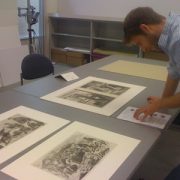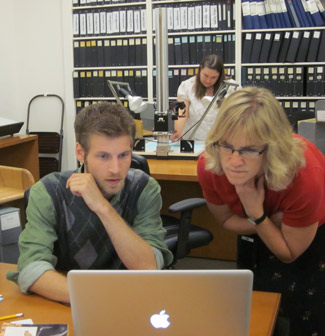annette shumway: summer at the smithsonian
We invited our recent Smithsonian Affiliate interns and visiting professionals to blog about their experiences in our “Summer at the Smithsonian” series. Below, Annette Shumway, intern partner from the Frost Art Museum (Miami, FL) shares the story of her summer internship at the National Postal Museum. Special thanks to Annette for this post!
As a graduate student in the Museum Studies Certificate program at Florida International University I’ve focused much of my research efforts on digitization projects being undertaken by museums and archives. I am particularly interested in the effective administration and proper usage of current technologies for digital projects and believe that without organization much time and resources could be wasted. I was looking for an internship that would provide a meaningful, sensory experience that would enhance all of the learning that I had acquired, but couldn’t quite find one. When my Museum Studies Coordinator suggested I look into Smithsonian Affiliations Internship Program (our campus museum –The Frost Art Museum- is a Smithsonian Affiliate), I was excited because I would actually be able to execute my own project at the Frost, after I acquired hands-on skills at the Smithsonian.
I was placed with Kate Diggle, Database Administrator at the National Postal Museum (NPM). At NPM digitization of the collection is a high priority. While at the museum I had the opportunity to work on two different projects involving digitization.
 We worked on one collection consisting of modern philatelic and postal history artifacts which are being transferred from the USPS to the National Postal Museum’s care. We re-housed, marked, and cataloged all of the objects during the first phase. Next, we created digital records for more than 4000 records down to the item level. Hard work, but we accomplished our task a month ahead of schedule! With the help of curators and conservation staff, we identified the items that would be the best candidates for imaging. Some of the artifacts in the collection were larger than the imaging equipment we had in-house, so we couriered these objects to a facility that would be able to handle our imaging needs. It was fascinating to courier the objects and to have access to some of the most state-of-the-art equipment in the field of image capture.
We worked on one collection consisting of modern philatelic and postal history artifacts which are being transferred from the USPS to the National Postal Museum’s care. We re-housed, marked, and cataloged all of the objects during the first phase. Next, we created digital records for more than 4000 records down to the item level. Hard work, but we accomplished our task a month ahead of schedule! With the help of curators and conservation staff, we identified the items that would be the best candidates for imaging. Some of the artifacts in the collection were larger than the imaging equipment we had in-house, so we couriered these objects to a facility that would be able to handle our imaging needs. It was fascinating to courier the objects and to have access to some of the most state-of-the-art equipment in the field of image capture.
The second project involved the actual image capture of artifacts for an upcoming exhibit. These images were added to the museum’s database and will be available online when the exhibit opens. This helps to preserve artifacts like letters from revolutionary war, civil war, and both world wars for future generations of researchers. Thanks to instruction from the preservations, collections, and web team at NPM, I was able to hone the handling, technical and editing skills necessary for completing projects in digitization field.
 Taking part in both of these projects has helped me understand the logistics behind coordinating loans and standards involved in collections’ imaging projects. I feel that much of the experience that I gained through this period will aid in the second portion of my internship at the Frost Art Museum. I look forward to contributing valuable knowledge to the digitization plan and efforts at the Frost.
Taking part in both of these projects has helped me understand the logistics behind coordinating loans and standards involved in collections’ imaging projects. I feel that much of the experience that I gained through this period will aid in the second portion of my internship at the Frost Art Museum. I look forward to contributing valuable knowledge to the digitization plan and efforts at the Frost.










